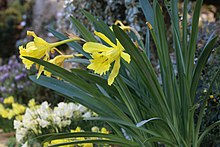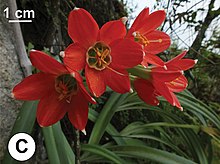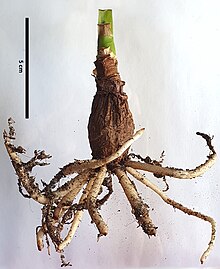| Paramongaia | |
|---|---|

| |
| Paramongaia weberbaueri | |

| |
| Detail of Paramongaia milagroantha flowers | |
| Scientific classification | |
| Kingdom: | Plantae |
| Clade: | Tracheophytes |
| Clade: | Angiosperms |
| Clade: | Monocots |
| Order: | Asparagales |
| Family: | Amaryllidaceae |
| Subfamily: | Amaryllidoideae |
| Tribe: | Clinantheae |
| Genus: | Paramongaia Velarde |
| Type species | |
| Paramongaia weberbaueri Velarde | |
| Synonyms | |
| |
Paramongaia is a genus of South American plants in the Narcissus Family ( Amaryllidaceae), the most important species being Paramongaia weberbaueri found only in the Andes of Peru and Bolivia. Common names are "giant Peruvian daffodil." and Cojomaria. Its appearance resembles the "King Alfred" Daffodil, but the flower is up to 7.25 inches (18.5 centimeters) in length by 7.5 inches (18.5 cm) wide with a corona 3.3 inches (8.5 cm) by 3 inches (8.5 cm) long by three inches (8 cm) wide.

Taxonomy
It was published by Octavio Velarde in 1949 with Paramongaia weberbaueri Velarde as the type species. After the genus was expanded, Paramongaia Velarde was conserved against the genus Callithauma Herb. published by William Herbert in 1837 with Callithauma viridiflorum (Ruiz & Pav.) Herb. as the type species.
Species
There are five recognized species:
- Paramongaia milagroantha (S.Leiva & Meerow) Meerow
- Paramongaia mirabile (Ravenna) Meerow
- Paramongaia multiflora Meerow
- Paramongaia viridiflora (Ruiz & Pav.) Meerow
- Paramongaia weberbaueri Velarde
Phylogeny
The following relationships were reported:
| |||||||||||||||||||||||||
Etymology
The generic name Paramongaia refers to Paramonga, Peru.
Conservation
The rare species Paramongaia weberbaueri has successfully been artificially propagated.
Ecology
Pollination
The flowers may possibly be moth-pollinated.
References
- ^ Missouri Botanical Garden. (n.d.-c). Paramongaia Velarde. Tropicos. Retrieved December 1, 2024, from http://legacy.tropicos.org/Name/40001382
- ^ "Paramongaia Velarde". Plants of the World Online. Royal Botanic Gardens, Kew. Retrieved 11 April 2023.
- Octavio Velarde. 1949. Lilloa 17: 489.
- Strange Wonderful Things, Rare and exotic plants & seeds, Paramongaia weberbaueri - the "Giant Peruvian Daffodil"
- Phillips, Roger; Rix, Martyn (1997). Random House Book of Indoor and House Plants - Volume two. New York: Random House. p. 251.
- Paramongaia Velarde. (n.d.). International Plant Names Index. Retrieved December 1, 2024, from https://www.ipni.org/n/296986-2
- ^ Meerow, A. W. (2020). Proposal to conserve the name Paramongaia against Callithauma (Amaryllidaceae).
- Meerow, A. W., & Nakamura, K. (2019). "Two new species of Peruvian Amaryllidaceae, an expanded concept of the genus Paramongaia, and taxonomic notes in Stenomesson." Phytotaxa, 416(2), 184-196.
- Mathew, B. (1997). 323. PARAMONGAIA WEBERBAUERI: Amaryllidaceae. Curtis’s Botanical Magazine, 14(3), 142–147. http://www.jstor.org/stable/45065245
- Dinkelman, K., Finnie, J. F., Drennan, P. M., & van Staden, J. (1989). "In vitro multiplication of Paramongaia weberbaueri." HortScience, 24(5), 860-860.
- Meerow, A. W. (2010). Convergence or reticulation? Mosaic evolution in the canalized American Amaryllidaceae. Diversity, phylogeny and evolution in the monocotyledons, 145-168.
External links
- Rare Plants, Pamianthe (Peruvian Daffodil) & Paramongaia (Peruvian Daffodil)
- Bulb Maven, Paramongaia weberbauerii
| Taxon identifiers | |
|---|---|
| Paramongaia | |